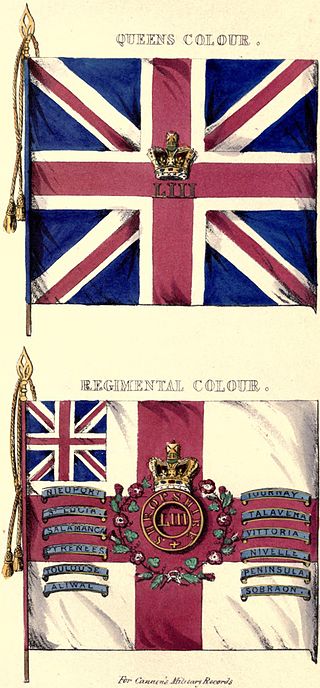Related Research Articles

The 53rd (Shropshire) Regiment of Foot was a British Army regiment, raised in 1755. Under the Childers Reforms it amalgamated with the 85th Regiment of Foot to form the King's Shropshire Light Infantry in 1881.
The 133rd (Highland) Regiment of Foot was a Scottish infantry regiment in the British Army, created in 1794 and disbanded in 1795. The regiment was raised in northern Scotland by Simon Fraser, and did not see any active service; it served solely to recruit soldiers. On disbandment, the recruits were drafted into other regiments.
The 130th Regiment of Foot was an infantry regiment of the British Army, created in 1794. After being raised it was sent to the West Indies, where it suffered heavy losses from tropical disease. The unit was disbanded at Santo Domingo in 1796, with the survivors drafted into other regiments.
The 124th Regiment of Foot was an infantry regiment of the British Army, formed in 1794 and disbanded in 1795.
The 100th Regiment of Foot, or the Loyal Lincolnshire Regiment, was an infantry regiment of the British Army, formed in 1780 and disbanded in 1785. The Loyal Lincolnshire Regiment was reformed in 1794 as the 123rd Regiment of Foot and was again disbanded in 1796.
The 116th Regiment of Foot was an infantry regiment of the British Army, formed in 1793 and disbanded in 1795, with some personnel sent to the 42nd Highlanders.
The 115th Regiment of Foot (Prince William's) was an infantry regiment of the British Army from 1794 to 1795. It was raised in May 1794, named for its colonel Prince William Frederick, Duke of Gloucester and Edinburgh, but was disbanded the following year.
The 114th Regiment of Foot was an infantry regiment of the British Army from 1794 to 1795. It was raised in April 1794 and was disbanded the following year.
The 113th Regiment of Foot was an infantry regiment of the British Army from 1794 to 1795.
The 112th Regiment of Foot was an infantry regiment of the British Army from 1794 to 1795. It was raised in July 1794 and stationed in Ireland.
The 111th Regiment of Foot (Loyal Birmingham Volunteers) was an infantry regiment of the British Army from 1794 to 1796. It was formed on 30 May 1794 and disbanded in February 1796.
The 110th Regiment of Foot was an infantry regiment of the British Army from 1794 to 1795.
The 109th (Aberdeenshire) Regiment of Foot was an infantry regiment of the British Army from 1794 to 1795. Raised by Alexander Leith Hay for service in the French Revolutionary Wars the regiment was briefly deployed in Jersey before it was disbanded in England and its men sent to reinforce the 53rd (Shropshire) Regiment of Foot. The disbandment was controversial as Leith-Hay believed it contravened an assurance given to him in his original letter of service to raise the regiment.
The 51st Regiment of Foot was a British Army line infantry regiment, raised in 1755. Under the Childers Reforms it amalgamated with the 105th Regiment of Foot to form the King's Own Yorkshire Light Infantry in 1881.
The 59th Regiment of Foot was an infantry regiment of the British Army, formed in 1755 in response to the threat of renewed war with France. Under the Childers Reforms it amalgamated with the 30th (Cambridgeshire) Regiment of Foot to form the East Lancashire Regiment in 1881.
The 107th Regiment of Foot was a short-lived infantry regiment of the British Army formed during the French Revolutionary Wars.
The 106th Regiment of Foot was an infantry regiment of the British Army from 1794 to 1795. It was raised in May 1794 at Norwich, and was disbanded in 1795.
The 102nd Regiment of Foot was a short-lived regiment of the British Army raised in 1793 and disbanded in 1795.
The 99th Regiment of Foot was an infantry regiment of the British Army, raised on 10 February 1794 by Lieutenant-Colonel Stuart Douglas and numbered as the 99th Foot in October of the same year.
The 105th Regiment of Foot had a brief existence as a British Army infantry regiment between 1794 and 1795. Its Regimental Colonel throughout its brief history was Colonel Gordon Forbes.
References
- 1 2 118th Regiment of Foot, National Archives Catalogue index.
- ↑ The Naval History of Great Britain, vol. 1, by William James. 1837. Online copy